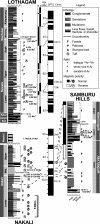Late Miocene to Pliocene carbon isotope record of differential diet change among East African herbivores
- PMID: 21464327
- PMCID: PMC3080981
- DOI: 10.1073/pnas.1018435108
Late Miocene to Pliocene carbon isotope record of differential diet change among East African herbivores
Abstract
Stable isotope and molecular data suggest that C(4) grasses first appeared globally in the Oligocene. In East Africa, stable isotope data from pedogenic carbonate and fossil tooth enamel suggest a first appearance between 15-10 Ma and subsequent expansion during the Plio-Pleistocene. The fossil enamel record has the potential to provide detailed information about the rates of dietary adaptation to this new resource among different herbivore lineages. We present carbon isotope data from 452 fossil teeth that record differential rates of diet change from C(3) to mixed C(3)/C(4) or C(4) diets among East African herbivore families at seven different time periods during the Late Miocene to the Pliocene (9.9-3.2 Ma). Significant amounts of C(4) grasses were present in equid diets beginning at 9.9 Ma and in rhinocerotid diets by 9.6 Ma, although there is no isotopic evidence for expansive C(4) grasslands in this part of the Late Miocene. Bovids and hippopotamids followed suit with individuals that had C(4)-dominated (>65%) diets by 7.4 Ma. Suids adopted C(4)-dominated diets between 6.5 and 4.2 Ma. Gomphotheriids and elephantids had mostly C(3)-dominated diets through 9.3 Ma, but became dedicated C(4) grazers by 6.5 Ma. Deinotheriids and giraffids maintained a predominantly C(3) diet throughout the record. The sequence of differential diet change among herbivore lineages provides ecological insight into a key period of hominid evolution and valuable information for future studies that focus on morphological changes associated with diet change.
Conflict of interest statement
The authors declare no conflict of interest.
Figures




References
-
- Quade J, et al. A 16-Ma record of paleodiet using carbon and oxygen isotopes in fossil teeth from Pakistan. Chem Geol Isot Geosci Sect. 1992;94:183–192.
-
- Kingston JD, Hill A, Marino BD. Isotopic evidence for neogene hominid paleoenvironments in the Kenya rift valley. Science. 1994;264:955–959. - PubMed
-
- Cerling TE, Quade J, Wang Y, Bowman JR. Carbon isotopes in soils and palaeosols as ecology and palaeoecology indicators. Nature. 1989;341:138–139.
-
- Feakins SJ, deMenocal PB, Eglinton TI. Biomarker records of late Neogene changes in northeast African vegetation. Geology. 2005;33:977–980.
-
- Ségalen L, Lee-Thorp JA, Cerling T. Timing of C4 grass expansion across sub-Saharan Africa. J Hum Evol. 2007;53:549–559. - PubMed
Publication types
MeSH terms
Substances
LinkOut - more resources
Full Text Sources
Other Literature Sources
Miscellaneous

